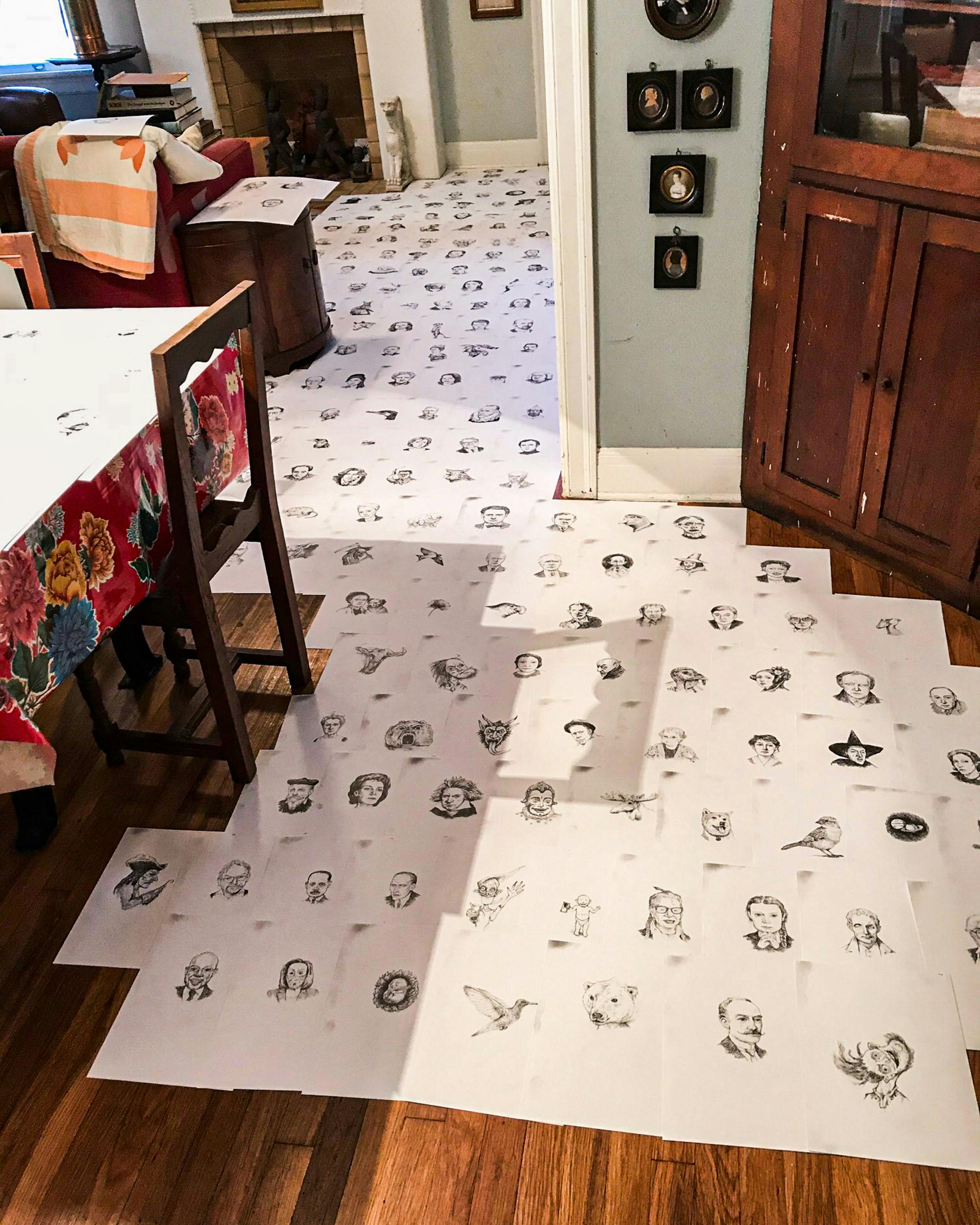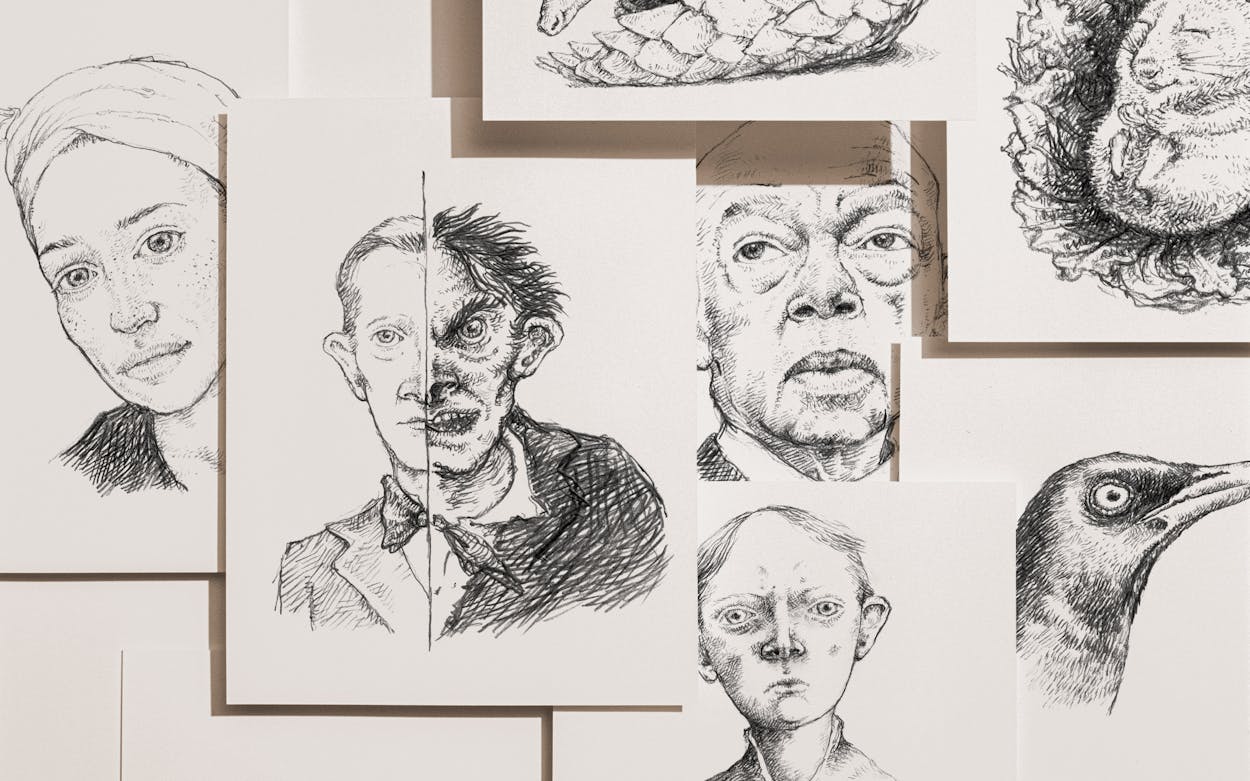In an ivy-covered bungalow in Austin’s quiet Hyde Park neighborhood, Edward Carey sits down at a well-lit dining room table every day around 4 p.m., picks up a pencil, and begins to sketch. This has been his routine since March 19, 2020, when he vowed to post a drawing a day until the pandemic had ceased, or as he put it, “until this nonsense is over.” Now, nearly a year later, Carey’s project is a quirky, poignant visual archive of pandemic life.
His first sketch was “A very determined young man,” a Dickensian-looking boy with a set mouth and a defiant gaze. A parade of characters, both famous and invented, quickly followed: King Lear, Greta Thunberg, a seventeenth-century plague doctor, a “gentleman wolf.” Sometimes Carey’s subjects are inspired by current events—as in April, when he sketched one of the goats that had recently taken over a locked-down Welsh village—and sometimes they simply arrive. “The pencil itself seems to lead the way,” he says. When he began the project, he hadn’t really thought about the labor involved, “nor did I know—nor do I know—how long it would go on for.”
Soon requests from family, friends, colleagues, and strangers began to flood in. Carey started keeping a list. A follower from Sardinia wanted a mouse; someone in London pined for a common parasitic bee fly. He obliged them both. Exotic animals—a pangolin, a tapir, a gnu—cohabitate with barnyard creatures, such as a sheep and a chicken, in this digital Noah’s Ark. Then there are the locals: grackles, a Highland cow, and a giant, venomous Texas redheaded centipede. Followers chime in about their favorites. “I love your grackles,” author Alexander Chee wrote.
Many of Carey’s portraits convey a deep passion for literature—perhaps not surprising, since he is also a novelist and playwright. Born in North Walsham, a small town in Norfolk, England, he knows several Shakespeare monologues by heart. In a series of sketches titled “Great British Hair,” writers Samuel Pepys, Charles Dickens, and Daniel Defoe made cameos. All three of the Brontë sisters have shown their distinct faces. To make the family complete, he added their brother, Branwell. In posts labeled “Heroes of Lockdown,” health tips and social-distancing reminders come from the likes of Lady Macbeth—who, Carey quips, “knew how to keep her hands clean,” and Henry David Thoreau, “who knew how to keep his distance.”


In late spring, as Black Lives Matter marchers took to the streets after the death of George Floyd, the tone of Carey’s work shifted. “I almost gave up,” he says. “What’s the point of drawing a chickadee when this is going on in America?” Then it occurred to him that he could say their names (and draw their faces):
Day 72. George Floyd
Day 73. Breonna Taylor
Day 74. Ahmaud Arbery
Day 76. David McAtee
On day 77, he drew James Baldwin, hand upturned, asking white America, “How much time do you want for your progress?”
Carey isn’t afraid to express what is at the forefront of his mind: “I’m drawing monsters again,” he announced in June, and he didn’t mean Medusa or the Jabberwocky, the sharp-toothed creature from Lewis Carroll’s poem (though he sketched those, too). Donald Trump and Mitch McConnell appeared with blood dripping ominously from their faces; William Barr had skeletons reflected in his glasses.
The Very Determined Young Man returned, ready to assist. He pops up again in fifty-day intervals, each time looking more grizzled and frazzled, until his head begins to rotate at a grotesque angle, mirroring the psychological toll of lockdown.
The day before the presidential election, Carey conveyed hope in the form of a swallow. Five days later, when the race was called for Joe Biden and Kamala Harris, he sketched his first double portrait, a drawing of the two celebrating. And the day before the 45th president left the White House, he drew what he names as his favorite portrait: “the back of Donald Trump’s head.” Carey also felt optimistic on December 8, when 90-year-old Margaret Keenan became the first person in the United Kingdom to get the coronavirus vaccine. He sketched her giving a double thumbs-up.

Those newsier sketches are balanced out by personal ones that feel homey and intimate. Carey sketched his family members on their birthdays: his son, Gus, turned 13; his daughter, Matilda, turned 12; and his wife, the author Elizabeth McCracken, was lovingly dubbed on her birthday his “beloved trouble and strife.” A stray cat named Maggie joined the family and became a feline muse. At the start of the fall semester at the University of Texas, where Carey is a creative writing professor, he drew Bevo, the longhorn, friend to thousands of incoming freshmen who won’t be getting the college experience they desired. Carey celebrated personal milestones: he turned 50; his novel The Swallowed Man came out; and after nine months, he got a haircut. Earlier this month, he shared that his pandemic drawings will soon become a book.
One snarky fellow told Carey on Twitter, “You must have a lot of time on your hands.” As a father, professor, writer, and artist, he promises his schedule is full. But let’s say for a moment that his fingers are currently smudged with small granules of graphite pencil, and that this statement rings true. Maybe at this very moment wood shavings are falling to the floor as another pencil becomes a nub. Maggie the cat looks up and blinks. Time. How lovely is that?
If we’re alive, we all have time on our hands. And, “alas,” as Carey is prone to say, anyone looking to undertake a year-long daily project should not fear time but simply let it be: “Don’t look ahead; don’t panic—just keep in the present; just make marks every day.”






